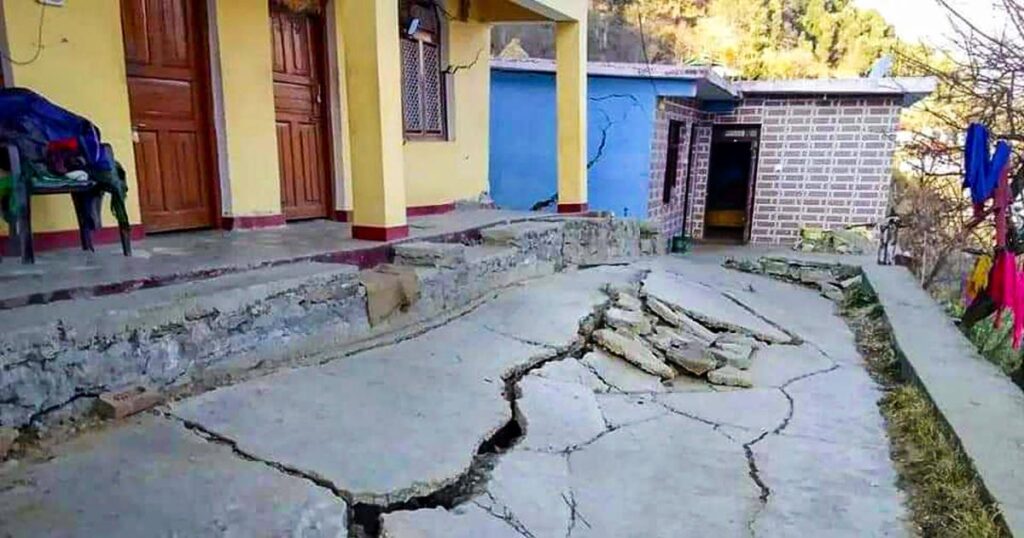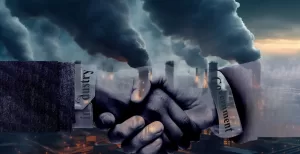❈ ❈ ❈
India’s Sinking Town a Disaster of Ignored Warnings
Residents of the ancient pilgrim town of Joshimath were forced to flee their homes in the freezing weather of January. Walls had cracked open, while foundations were tilting and sinking in a quarter of the approximately 2,500 buildings in the town. Federal and Uttarakhand state government officials are moving thousands of residents into hotels while halting all work on road widening and a hydropower project. Experts point out that this was a disaster waiting to happen because the authorities ignored multiple warnings over decades about the way roads and hydropower projects were being built.
Prime Minister Narendra Modi spoke to Uttarakhand Chief Minister Pushkar Singh Dhami over the weekend to check on rehabilitation, while the Prime Minister’s Office declared Joshimath a “landslide-subsidence zone” and asked experts to prepare short- and long-term plans on what to do.
But there has been no lack of expert advice or warnings, it is just that these have been repeatedly ignored before the Joshimath disaster unfolded.
Less than a week ago, a delegation of Joshimath residents who went to Uttarakhand capital Dehradun to complain about cracks in their houses due to construction work reportedly only managed to get five minutes with the Chief Minister. “He told us our fears are unfounded and sent us away without listening to us,” a member of the delegation told The Third Pole, speaking on the condition of anonymity.
This was on January 4, a day before cracks widened so quickly in so many houses and roads that residents forced managers of the local Tapovan-Vishnugad hydropower project to halt all tunnelling work. The same night, district officials made a count of affected buildings. The count had gone up by January 8 evening.
The Joshimath disaster
Kalachand Sain, head of the Dehradun-based Wadia Institute of Himalayan Geology, said Joshimath – a town 2,000 m above sea level – has always been vulnerable because it sits atop the debris of an old landslide. This has failed to stop a building spree in recent years, with ill-planned construction destabilising the soil and choking underground water channels, so that water starts accumulating under the foundations.
This process has been accelerated manifold by the work to widen the road to Badrinath – another pilgrimage centre higher up in the Himalayas. That road is part of the Char Dham (Four Pilgrimage Centres) road widening project. There have been multiple reports that trees are being cut and natural water channels choked because the project is failing to follow the government’s own principles on how to build a road in a mountain area. The road widening work has now been halted.
The other large threat multiplier is the Tapovan-Vishnugad hydropower project of the National Thermal Power Corporation Limited. This is a run-of-the-river electricity generation project that entails boring a tunnel over 12 km in length through the hillside and channelling the water of the Dhauli Ganga river through the tunnel to generate electricity.
National Thermal Power Corporation Limited was quick to point out on January 5 that its tunnel did not pass below Joshimath and should not be considered responsible for the disaster. But it does pass through the same aquifer that is below Joshimath.
Piyoosh Rautela – now the executive director of Uttarakhand Disaster Mitigation and Management Centre of the Uttarakhand state government – had co-authored a letter to the Current Science journal in 2010. In the letter, written on December 24, 2009, he had warned that the tunnel boring machine being used by the National Thermal Power Corporation Limited punctured an aquifer allowing the water to move in a different direction underground, drying out the springs on which many residents of Joshimath depend for their household water supply. Rautela has now said the sinking of Joshimath “is likely caused by aquifer breaches as we see muddy waters pouring out”. However, he added, “there is no evidence yet to link or delink it with the hydel tunnel.”
Hemant Dhyani, another expert, said, “Only a water test can tell if the streams erupting in the town are from the hydel tunnel.” He felt the National Thermal Power Corporation Limited had been premature in disclaiming any connection with the Joshimath disaster.
This is the same hydropower project where around 200 workers were killed after being trapped in a flash flood within the tunnel on February 7, 2021. That flash flood had been caused by the collapse of an ice wall – which experts ascribed to climate change impacts – on the slopes above the Rishi Ganga, a tributary to the Dhauli Ganga. All these rivers are part of the Ganga basin, India’s largest river basin.
After Joshimath disaster
While the authorities try to resettle the suddenly homeless people of Uttarakhand and await the recommendations the expert committee it has set up, locals are fretting. Atul Satti, a local environmental activist, told The Third Pole, “We demand instant action from the government that must include immediate stalling of the National Thermal Power Corporation Limited project, closure of Chardham all-weather road (Haleng-Marwari Bypass), implementation of National Thermal Power Corporation Limited’s pact that insures houses, setting a committee for rehabilitation of Joshimath within a set time frame, providing immediate help to all the affected people that include compensation, food, shelter and other basic facilities and participation of local representatives” while deciding development projects.
Anjal Prakash, research director and adjunct associate professor at the Bharti Institute of Public Policy, Indian School of Business and Lead Author for Intergovernmental Panel on Climate Change Reports, said in a statement, “There are two aspects to the Joshimath problem. First is rampant infrastructure development which is happening in a very fragile ecosystem like Himalayas… Secondly, the way climate change is manifesting in some of the hill states of India is unprecedented. For example, 2021 and 2022 have been years of disaster for Uttarakhand. There have been numerous climate risk events like high rainfall events triggering landslides. We have to first understand that these areas are very fragile and small changes or disturbances in the ecosystem will lead to grave disasters, which is what we are witnessing in Joshimath.” He emphasised the need for a “strong planning process” before any development projects were taken up in such fragile ecosystems. “Joshimath is a clear example of what one should not do in the Himalayas.”
YP Sundriyal, head of the geology department at the Hemvati Nandan Bahuguna Garhwal University, pointed out that Joshimath does not have a proper drainage system, so “water percolation has decreased the cohesive strength of the rocks over the time. This has resulted in landslides, triggering cracks in the houses. Climate change is further worsening the matter, with more extreme weather events. We need to have the formation of some strong rules and regulations and moreover forced and timely implementation of these rules.”
An emerging pattern
Joshimath is an ancient pilgrim town, and its plight is making news headlines. But it is not the only one facing problems in the Himalayan region. There have been reports of houses developing cracks near the sites of many hydropower projects in Uttarakhand and Himachal Pradesh. Even Bhutan, which has showcased its run-of-the-river hydropower projects as environmentally friendly, has towns with cracked buildings. Beyond just the impact of large hydropower projects is the way that expert advice and warnings, often of the government itself, is put aside in the rush to build infrastructure in the fragile Himalayan landscape. While there may be short-term profits for some construction firms, the long-term risks and costs are borne by the residents of these regions as well as by the state exchequer. It is past time that experts are listened to before the disasters rather than asked what to do after the disasters they predicted have happened.
(Joydeep Gupta is South Asia Director of The Third Pole. Courtesy: The Third Pole, a multilingual platform dedicated to promoting information and discussion about the Himalayan watershed and the rivers that originate there.)
As Cracks Widen in Joshimath, Reasons Lay Hidden Underground
Kundan Pandey
About four months ago, in September 2022, a state government report confirmed that Joshimath, a town in Uttarakhand, situated at an altitude of 1,875 metres, is sinking. Last week, a preliminary report by the Indian Space Research Organisation (ISRO)’s National Remote Sensing Centre (NRSC) showed satellite pictures confirming a rapid subsidence event in early January in Joshimath.
Experts that Mongabay-India spoke to, following the rapid subsidence situation in Joshimath, have linked the land subsidence – or the sinking of land – to the most recent case of cracks developing in houses. As of January 17, 849 houses had developed cracks and 838 people had been evacuated.
According to the NRSC satellite-based preliminary study, which is now no longer in the public domain, Joshimath, the gateway to many famous pilgrimage sites, including Auli, Badrinath, and Hemkund Sahib, sank 5.4 cm in just 12 days. The report noted that between April and November 2022, Joshimath sank by 8.9 cm. But a rapid subsidence event occurred between December 27, 2022, and January 8, 2023, during which the land subsided by 5.4 cm and over a larger area as well.
This report, however, has been removed from the ISRO site after getting instruction from the National Disaster Management Authority (NDMA), which restricted government organisations from interacting with media, claiming it is “creating confusion”. Experts that Mongabay-India spoke to, however, feel that the free flow of information and knowledge-sharing is important at this time.
While there has been awareness, discussion and government committee recommendations about land subsidence in Joshimath for decades, a renewed set of complaints came in 2022 from residents, following which the Uttarakhand State Disaster Management Authority commissioned a study. A multi-institutional team, comprising experts from IIT Roorkee, Geological Survey of India (GSI), Central Research Building Research Institute (CBRI) Roorkee, Wadia Institute of Himalayan Geology, and Uttarakhand State Disaster Management Authority (USDMA), arrived in Joshimath in August 2022 to study the causes of ongoing subsidence and suggest remedial measures.
In its report, submitted in September 2022 following a four-day survey, the team noted that there is evidence of ground subsidence happening in Joshimath and surrounding areas. It highlighted that the town in Chamoli district lies on an unstable foundation – a fact that is well-documented, with one of the earliest records being from 1886 when Edwin T. Atkinson wrote about landslide debris where the town is based in the Himalayan Gazetteer. Referring to the land subsidence in Joshimath, the USDMA report notes, “Joshimath and surrounding areas are known to experience ground subsidence since the Mishra Committee Report of 1976. After almost 50 years, there exists no data, record or report that could help in analysing and studying the state of affairs scientifically in a sequential manner; either with regard to the ground subsidence or measures put in place in accordance with the recommendations of the Mishra Committee and others that were constituted afterwards.”
Protests blame hydro project
As cracks in Joshimath homes widen and residents are displaced, protests have started emerging. Many parts of Joshimath are witnessing protests from people who put up banners against NTPC, the public sector energy conglomerate building large hydro projects near the town. Experts, residents, activists and others attribute the ongoing situation of cracking homes, triggered by rapid subsidence, in Joshimath, to the NTPC Tapovan Vishnugad Hydro Electric Project (HEP) and the Char Dham national highway project.
However, NTPC has dismissed its role in the situation. According to a media report, NTPC noted that the Tapovan Vishnugad hydroelectric project is 1.1 kilometres from the town and 1.1 kilometres below the ground – by which it means that the projects are at sufficient distance and not in a position to accelerate land subsidence. NTPC has submitted this information to the union Ministry of Power, which sought NTPC’s explanation regarding its role in the subsidence of the town.
S.P. Sati, a professor of geology at the College of Forestry in Tehri Garhwal, says there is a need for a proper study to understand the impact of these projects on Joshimath. The water from the Dhauliganga at Tapovan, where the tunnel for the Tapovan-Vishnugad project begins, should be compared to a sample of water leaking at Marwadi of Joshimath. It will give a sense whether the power project has any connection with the land subsidence, he added.
Joshimath situated on old landslide debris
Y.P. Sundriyal, a professor and head of the geology department at the HNB Garhwal University, recently wrote a discussion paper on the precarious situation of Joshimath and Bhatwari, two Himalayan towns in Uttarakhand. The paper, written along with researchers from Doon University, Uttarakhand, Oslo Metropolitan University, Norway and National Geotechnical Facility, Uttarakhand is a pre-print and currently under review for the journal Natural Hazards and Earth System Science.
The pre-print attempts to estimate the possible displacement of land (sinking) in the future, in different scenarios and notes that based on factors such as gravity, rainfall, building load, domestic discharge, and seismic load, “the displacement in these hillslopes (sinking of land) might reach up to 20-25 metres that will further aggravate the situation” of subsidence in these disaster-prone towns.
The paper notes that the town is situated along a narrow gorge at the confluence of two major rivers; Dhauliganga and Alaknanda and is close to the Main Central Thrust (MCT) fault passing through on the southern side of town. So, it is prone to earthquake and also frequent rainfall.
Sundriyal explains that Joshimath is located on the debris of an old landslide and there are fine materials like clay, soil, etc. between the boulders. Highlighting the role of seeping water (natural and anthropogenic drainage) in the current situation in Joshimath, he said that when the drainage water seeps through the surface and goes underground, it loosens the material that is locked between boulders, which in turn shifts the boulders.
Another researcher, Vipin Kumar from the Department of Geology, Doon University, who was part of this study, says that Joshimath town is situated on an active paleo landslide which means the landslide debris, including soil, boulders, and other materials, continue shifting. However, it is likely that the displacement (of slope materials) might have increased in the last three to four months.
Kumar notes that the high number of tourists that visit Joshimath leads to high extraction of groundwater and also discharge of liquid waste which seeps into the ground and affects the already-weak natural regime. He added that their study found that those areas, where there are a high number of people and discharge of liquid waste, will get the most displacement in the form of hilltop material sliding down.
Similar situation arising in neighbouring areas
There are many villages across the state where cracks have been developing in the houses over the last several years. Other than Joshimath, Dar, a village of the Darma valley in Uttarakhand’s Dharchula sub-division has witnessed cracks in houses. Experts say that about 200 villages of the Dharchula and Munsyari sub-divisions are developed on paleo landslides and are prone to subsidence.
Syana Chatti in Yamuna Valley, Kharsali Janki Chatti, Bhatwari in Bhagarithi valley, a few villages in Bhilanghana Ghati are some of the other areas where houses are witnessing cracks currently, says Kumar. From Jaggi Bhagwan area in Mandakini valley people are already leaving their homes, Joshimath and Karnprayag are already in the news, there are many villages in Kaali valley as well, he said adding that there is no official record of habitations where cracks are witnessed.
There is a list of 395 villages that the Uttarakhand state government has identified between 2018 to 2021 as prone to disasters and that need to be relocated immediately.
According to S.P. Sati, there are many other towns across the Himalayas, especially in Uttarakhand – such as Gopeshwar, Pauri, the upper part of Srinagar, Guptakashi, a part of Augustmuni, Munsiyari, and a big portion of Nainital – where unplanned growth is happening, and they may face a similar fate in the coming future. It is almost impossible to save Joshimath but we should learn a lesson from here and use it to protect other towns and cities, he added.
Like Uttarakhand, its neighbouring state Himachal Pradesh is also facing a similar situation of land subsidence. On January 16, while speaking at the 148th Foundation Day of the India Meteorological Department (IMD), the chief minister of Himachal Pradesh, Sukhvinder Singh Sukhu, said that many places in the state are gradually experiencing land subsidence and urged the centre to take timely measures to avoid the Joshimath-like situation.
(Courtesy: Mongobay-India, a conservation and environment news and features service that aims to bring high quality, original reports from nature’s frontline in India.)




